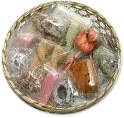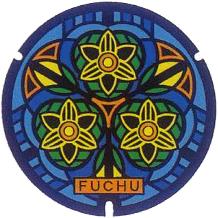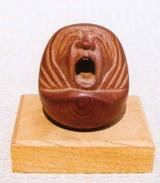[ . BACK to DARUMA MUSEUM TOP . ]
:::::::::::::::::::::::::::::::::::::::::::::::::::::::::::::::::::::::::::::::::::::::::::::::::::::
ME 目 Blue Eyes of Daruma san
.. .. .. 青い目のだるまさん
aoi me no Daruma
for komainu, see below

A friend asked about paintings of a Daruma with blue eyes. Since most painings of Daruma san are in the Zen-painting tradition (zen-ga 禅画), they are in black and white ink. But Daruma, as an Indian Monk, might have blue eyes.
.. .. .. .. Let us see what we find in the Internet.
Then, about fourteen hundred years ago Bodhidharma (Bodhidharma in Sanskrit, Pu-Ti-Ta-Mo, Buti-Damoin or Ta-mo in Chinese, Bodai Daruma in Japanese) who was a Buddhist master and an accomplished Kshatriya warrior, left western India, penetrating mountain ranges including the Himalayas and crossing unbridged rivers through complete wilderness, to travel to China and present lectures on Buddhism.

Ferociously ugly,
with wide, piercing blue eyes; and bearded with wild curly hair, who was known as he arrived in China as a "barbarian", is now known as the founder of Ch’an (Zen) Buddhism and of the Shaolin arts. Some historical notes have him arriving in Canton, China at 470 AD, leaving there and arriving next in Ching-Ling (which is now Nanking).
Since even present roads between India and China would not be described as good, one can only imagine the greatness of Bodhidharma's spirit and physical strength as he made this several thousand mile trip alone. This journey was the death bed wish of his master Prajnatara who wished to spread the "sudden" philosophy of Chan Buddhism outside of India proper and particularly to the land of Song Dynasty China.
quote from ohio shaolin
The blue-eyed Founder of Shaolin & Chan Buddhism
http://www.ohioshaolindo.com/SHAOLINDO%20Images/tamo.htm
.....................................................................................................................
Actually, Kung Fu was introduced to China
by a man whose BLUE EYES supposedly burned a hole through a wall, according to the legend. His name was Bodhidharma, and he is mentioned as "the blue-eyed devil" in the quote below.
Another thing we always see in the Orient is the Buddha, whose statues are all very Oriental-looking. Actually, Buddha was an Aryan who lived and died in India.
As one Buddhist puts it,
"We're all prepared to visualize
the Buddha's blue eyes. He was an Aryan, of European descent, a nobleman in a societal caste system that did not ‘officially' intermarry with native populations. The rigidity of the system can be seen even in further generations. Nearly a thousand years later,
Bodhidharma, another Aryan descendant, was called
The Blue Eyed Demon by the Chinese.'"
http://www.whitakeronline.org/021404.htm
.....................................................................................................................
Buddhas Eyes are like a Blue Lotus
 The countenance of the Buddha is like the clear full moon,
Or again, like a thousand suns releasing their splendour.
His eyes are pure, as large and as broad as a blue lotus.
His teeth are white, even and close, as snowy as white jade.
The countenance of the Buddha is like the clear full moon,
Or again, like a thousand suns releasing their splendour.
His eyes are pure, as large and as broad as a blue lotus.
His teeth are white, even and close, as snowy as white jade.
- from the Suvarnaprabhasa (Suvarnabhasottama) Sutra
Interesting Article about the perception of the Color BLUE.
http://www.hsuyun.org/Dharma/zbohy/Literature/essays/czs/bluelotus.html
.......................................................................................................................
Bodhidharma is revered as the founder of kung fu. He introduced kung fu exercises to the monks of the Shaolin temple after gaining entry around 497AD. Legend states that he cut off his eyelids to stay awake in meditation and
had piercing blue eyes.
http://members.lycos.co.uk/xuy/a2z/zen.htm
.......................................................................................................................
.. .. .. .. .. .. .. .. .. .. .. .. .. ..
History of Taekwondo
Bodhidharma
was a disciple of the priest Prajinatara, who later became the 28th descendent of Skaka (the founder of Buddhism). Bodhidharma was a colorful character;
Chinese writers refer to him as the "blue-eyed barbarian. "
He is often depicted as a balding man with a beard, potbelly, and
blue eyes. He was most probably born in Kanchipuran (near Madras), India. He was probably the son of a lesser member of the warrior caste, but there are some indications he may have been of the mixed priest-warrior caste "Brahaman-Kshyatriya"; the clue being his Caucasoid features. Although heir to a throne, Bodhidharma chose the life of a religious devotee.
http://www.uta.edu/student_orgs/umaa/htmlDocs/history.html
..........................................................................................................................
People of Old Along the Silk Road
On this page, you will see wall paintings from the tomb of Princess Yongtai at the site of the Qian Ling tombs, Shaolin Monastery, and from the grottoes at Dunhunag, Kizil and Bezeklik.
Other figures, shown kneeling before the Buddhas offering gifts, were of particular interest to von Le Coq since they depicted individuals in costumes of different nationalities. They included Indian princes, Brahmins, Persians --
and one puzzling character with red hair, blue eyes and distinctly European features."
source . mary mount
.......................................................................................................................
Kites of Daimon Town 越中だいもん凧まつり
One of these kites features a
Daruma with blue eyes.
 Poster for the Kite Competition Heisei 20
This Kite pattern is also on a large tile design in the town.
Poster for the Kite Competition Heisei 20
This Kite pattern is also on a large tile design in the town.
 And my Daruma Story about Kites:
And my Daruma Story about Kites:
- wadako 和凧 Japanese Kite -
.......................................................................................................................
Tea Legends and the Blue-eyed Daruma
Daruma, the blue-eyed prince from India, did long sessions of zazen in China and cut off his eyelids, because he wanted to prevent going to sleep. From the cast-off eyebrows the tee tree emerged, with his envigorating dring helping the meditating Daruma.
お茶について最も広く知られている伝説に登場するのは、紀元前2800年ごろに中国を治めていたとされる 神農(神の農夫)である。彼は哲学者、本草家としても知られていた。山野をかけ巡り、日に72種もの野草 や木の葉などを口にして効能を調べ、そのたびごとに茶の葉を用いて毒を消していたのがその始まりとされて いる。 これとは別にもうひとつの伝説がある。お茶の始まりを仏教伝播(でんぱ)に結びつけるもので、その時期 は、実際の発祥よりも後のこととされている。インドの青い目の王子、菩提達磨(ぼだいだるま)が主人公で ある。彼は何年もの間、一睡もせずに修行を続けたと言われている。修行の座禅中、睡魔に襲われ不覚にも 眠ってしまった。目覚めた彼は、無念の思いから自らに愛想をつかし、自分のまぶたを切り取り捨てた。その 後5年以上も眠らず座禅を続けるが、再び眠ってしまった。彼は目を覚ますと、近くにあった木の葉をかんで みた。するとたちまち眠気が覚めた。これこそお茶に含まれる成分の代表的なカフェインの効果である。
source
ichigashira.com
だるまは こうしこくのおうじ kooshi koku no ooji / 香至国 の第三王子 Prince from Koshi
..........................................................................................................................

The Daruma above is from my collection. He is made from clay and about 19 cm high.
Kokeshi set on a piece of wood with blue eyes.
 xxxxxxxxxxxxxxxxxxxxxxxxxxxxxxxxxxxxxxxxxxxxxxx
.. .. .. .. .. .. .. .. .. .. .. .. Further Reading
xxxxxxxxxxxxxxxxxxxxxxxxxxxxxxxxxxxxxxxxxxxxxxx
.. .. .. .. .. .. .. .. .. .. .. .. Further Reading
Me-ire - Painting Eyes for Daruma 達磨の目入れ
Daruma and his EYES
The Eye-Opening Ceremony of a Buddha Statue
http://groups.yahoo.com/group/Darumasan-Japan/message/138
....................................................................................................
Comments from my readers:
The ancient 12-13th c.
Korean history "Samguk Yusa" describes
Tamo (Daruma) as a blue-eyed barbarian. "The Blue Cliff Records" of Japan label him as"that old blue-eyed barbarian".
Coupling this info. with the Silk RoadTrade, considering that Chinese interacted with Nordics through that very route, literary references to Nordics (Aryans), that artistic works refer to non-European Whites, and
that "blue-eyed barbarian" was apparently used as a general term for White strangers (from Xinjiang, Persia, India, C. Asia,etc. - where else would they come from?), makes the chances of Daruma being a White Man (he was from the Warrior Caste) with blue eyes quite apossibility; just like the Buddha.
Ali
- darumasan forum yahoo
:::::::::::::::::::::::::::::::::::::::::::::::::::::::::::::::::::::::::::::::::::::::::::::::::::::::::::::::::::::::::::
aoi me no komainu 青目の狛犬
Koma-Inu with blue eyes
They have stone eyes of blue color.
. komainu, koma inu 狛犬 "lion dog" .
Lit. 'Korean dog'. - Introduction
 - photo by Yasue M. san -
- photo by Yasue M. san -
from 白鳥神社 - 宮城県柴田郡村田町
 - photo by Takashi G. san -
- photo by Takashi G. san -
from 人麻呂神社 栃木県
- source : Shinto Shrines facebook -
. . . CLICK here for Photos !
:::::::::::::::::::::::::::::::::::::::::::::::::::::::::::::::::::::::::::::::::::::::::::::::::::::::::::::::::::::::::::
[ . BACK to DARUMA MUSEUM TOP . ]
[ . BACK to WORLDKIGO . TOP . ]
:::::::::::::::::::::::::::::::::::::::::::::::::::::::::::::::::::::::::::::::::::::::::::::::::::::::::::::::::::::::::::

















































